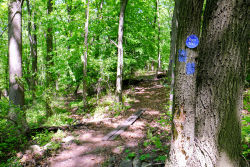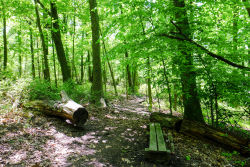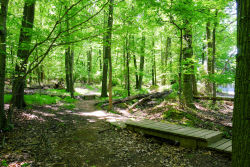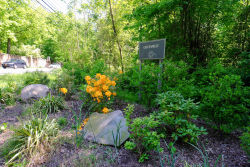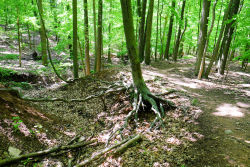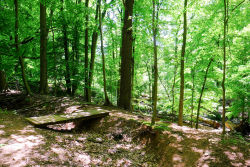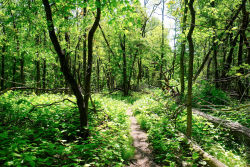Deere Park
Deere Park
It is perhaps ironic that this parkland wilderness bears the name of one of the world’s foremost manufacturers of farm equipment, John Deere (1804-1886). Deere was born in Rutland, VT and pursued a common school education and four-year apprenticeship as a blacksmith. His workmanship was highly respected, but worsening economic conditions soon forced the young man to move west to Illinois. In 1837, just one year after his arrival in Grand Detour, IL, John Deere made history. From the steel blade of a broken saw, he created the world’s first ‘self-scouring’ plow. His invention solved a pressing problem for farmers attempting to adjust to the rich, sticky midwestern soil, revolutionizing farming in that region forever.
Deere’s innovations did not end with his first success. Using steel imported from England he expanded his company, moving operations to Moline, IL, which remains John Deere’s headquarters to this day. Deere’s son Charles (1837-1907), who acted as vice president and treasurer since 1867, succeeded him as the president of the company. Charles was an excellent businessman who put his energies into marketing and diversification. He created marketing centers in every region that sold the varied line of Deere farm implements to independent retailers.
Charles was the first Deere recorded as the owner of this property. One of Charles’s two daughters, Katherine, married William Butterworth, who became the third president of the Deere corporation. It was under Butterworth that Deere & Company took over the Waterloo Gasoline Traction Engine Company, and began producing tractors in 1918. John Deere tractors are now perhaps the company’s best known product.
Deere Park is bound by Milford Drive, Dresden, Tiber, and Deere Park Places, Butterworth Avenue, the Staten Island Boulevard, and by woodland once intended for the abandoned Richmond Parkway project. Deere Park Place was renamed from Saratoga Avenue in 1948 by local law, at the request of Borough President Cornelius A. Hall. Parks acquired the land on February 9, 1973 in a land exchange for the property adjacent to the Staten Island Expressway. Commissioner Stern named the parkland Deere Park in 1996. In 1997 Mayor Giuliani allocated $20,664 for the installation of fences, guiderails, and for general site work at the Korean War Memorial in the park.
Kettle holes, steep hills and large boulders in Deere Park are marks of glacial movement from the last Ice Age, which ended about 12,000 years ago. The variety of soils deposited during the glacier’s passage allowed a diversity of plant and animal species to inhabit the region. Today, these areas function as resting places for migratory birds. A thick oak (Quercus spp.) forest dominates the property, with an undergrowth speckled by azaleas and wild blueberries (Vaccinius spp.) The Blue trail, one of the four major hiking trails of the Staten Island Greenbelt, begins at the entrance located at the bottom of Staten Island Boulevard. During the Revolutionary War, the all-encompassing view near the top of Todt Hill Road and Ocean Terrace was used as a lookout point for the occupying British forces. Today it leads hikers all the way up the hill to one of the highest points on the eastern seaboard.
Check out your park's Vital Signs
Clean & Safe
Green & Resilient
Empowered & Engaged Users
Share your feedback or learn more about how this park is part of a
Vital Park System


